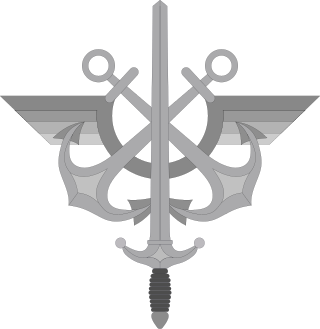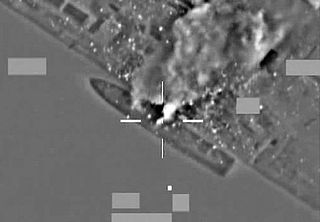Related Research Articles

A carrier battle group (CVBG) is a naval fleet consisting of an aircraft carrier capital ship and its large number of escorts, together defining the group. The CV in CVBG is the United States Navy hull classification code for an aircraft carrier.

The French Armed Forces are the military forces of France. They consist of four military branches – the Army, the Navy, the Air and Space Force and the National Gendarmerie. The National Guard serves as the French Armed Forces' military reserve force. As stipulated by France's constitution, the president of France serves as commander-in-chief of the French military. France has the ninth largest defence budget in the world and the third largest in the European Union (EU). It also has the largest military by size in the EU. As of 2021, the total active personnel of the French Armed Forces is 270,000. While the reserve personnel is 63,700, for a total of 333,000 personnel. If we include the active personnel of the National Gendarmerie, the total men power of all the French Armed Forces combined is 435,000 strong. A 2015 Credit Suisse report ranked the French Armed Forces as the world's sixth most powerful military.

The Australian Defence Force (ADF) is the military organisation responsible for the defence of the Commonwealth of Australia and its national interests. It consists of three branches: the Royal Australian Navy (RAN), Australian Army and the Royal Australian Air Force (RAAF). The ADF has a strength of just over 89,000 personnel and is supported by the Department of Defence alongside other civilian entities.

Australia joined a U.S.-led coalition in the Iraq War. Declassified documents reveal that the decision to go to war was taken primarily with a view to enhancing its alliance with the United States.

Aerial refueling (en-us), or aerial refuelling (en-gb), also referred to as air refueling, in-flight refueling (IFR), air-to-air refueling (AAR), and tanking, is the process of transferring aviation fuel from one aircraft to another while both aircraft are in flight. The two main refueling systems are probe-and-drogue, which is simpler to adapt to existing aircraft and the flying boom, which offers faster fuel transfer, but requires a dedicated boom operator station.

Operations Black Buck 1 to Black Buck 7 were seven extremely long-range ground attack missions conducted during the 1982 Falklands War by Royal Air Force (RAF) Vulcan bombers of the RAF Waddington Wing, comprising aircraft from Nos. 44, 50 and 101 Squadrons, against Argentine positions in the Falkland Islands. Five of the missions completed attacks. The objective of the missions was to attack Port Stanley Airport and its associated defences. The raids, at almost 6,600 nautical miles and 16 hours for the round trip, were the longest-ranged bombing raids in history at that time.

Charles de Gaulle is the flagship of the French Navy. The ship, commissioned in 2001, is the tenth French aircraft carrier, the first French nuclear-powered surface vessel, and the only nuclear-powered carrier completed outside of the United States Navy. She is named after French president and general Charles de Gaulle.

The Formidable-class multi-role stealth frigates are multi-mission derivatives of the French Navy's La Fayette-class frigate in service with the Republic of Singapore Navy. The six ships form the First Flotilla of the Navy.

The 128th Air Refueling Wing is a unit of the Wisconsin Air National Guard, stationed at General Mitchell Air National Guard Base, Milwaukee, Wisconsin. If activated to federal service in the United States Air Force, the wing is operationally gained by the Air Mobility Command (AMC).
The Strategic Defence and Security Review 2010 was announced by the formed Conservative-Liberal Democrat coalition government of the United Kingdom in May 2010, and published on 19 October 2010. The previous major review of UK defence strategy was the Strategic Defence Review, published in 1998, and updated in 2003 by the Delivering Security in a Changing World white paper.
The 1981 Defence White Paper was a major review of the United Kingdom's defence policy brought about by the Conservative government under the Prime Minister Margaret Thatcher. The main author was the then Secretary of State for Defence, John Nott. The aim of the review was to reduce expenditure during the early 1980s recession and to focus on supporting NATO rather than out of area operations. It was ultimately judged however to have been extremely detrimental to the United Kingdom's defence posture, being one of the contributing factors that led to the outbreak of the Falklands War.

Operation Ellamy was the codename for the United Kingdom participation in the 2011 military intervention in Libya. The operation was part of an international coalition aimed at enforcing a Libyan no-fly zone in accordance with the United Nations Security Council Resolution 1973 which stipulated that "all necessary measures" shall be taken to protect civilians. The coalition operation was designated by NATO as Operation Unified Protector, by the US as Operation Odyssey Dawn. The Canadian participation as Operation Mobile and the French participation as Opération Harmattan. It was confirmed in December 2011 that the cost of the operations was £212m – less than was estimated, including £67m for replacing spent munitions, is all expected to be met from the Treasury reserve.

Operation Mobile was the name given to Canadian Forces activities in the 2011 military intervention in Libya. The United States' counterpart to this was Operation Odyssey Dawn, the French counterpart was Opération Harmattan and the British counterpart was Operation Ellamy. The no-fly zone was proposed during the Libyan Civil War to prevent government forces loyal to Muammar Gaddafi from carrying out air attacks on anti-Gaddafi forces and civilians. The demonstrations in Libya were part of the larger Arab Spring movement that began in the country of Tunisia on 18 December 2010. When demonstrations began in Libya, the government of Muammar Gaddafi responded with systematic attacks by air and ground forces, and repression of the protesters. In a speech, Gaddafi promised to chase down the protesters and cleanse the country "house by house". Several countries prepared to take immediate military action at a conference in Paris on 19 March.

Operation Unified Protector was a NATO operation in 2011 enforcing United Nations Security Council resolutions 1970 and 1973 concerning the Libyan Civil War and adopted on 26 February and 17 March 2011, respectively. These resolutions imposed sanctions on key members of the Gaddafi government and authorized NATO to implement an arms embargo, a no-fly zone and to use all means necessary, short of foreign occupation, to protect Libyan civilians and civilian populated areas.

AirTanker Services Limited, incorporated in England and Wales on 14 June 2007 with the company registration number 06279646, is a private limited company in the United Kingdom (UK), which operates a British airline known as AirTanker, and is also an aircraft leasing and operating company.
The 2013 French White Paper on Defense and National Security is the most recent defence reform of the French Armed Forces and the fourth ever defence white paper in French history. It was released on the 29 April 2013. The white paper reaffirmed France's commitment to NATO, the security of the European Union as well as its enhanced defence-relationship with the United Kingdom after the 2010 Lancaster House treaties on defence and security co-operation.

Operation Shader is the operational code name given to the contribution of the United Kingdom in the ongoing military intervention against the Islamic State of Iraq and the Levant. The operation involves the British Army providing ground support and training to allied forces fighting against ISIL, the Royal Air Force providing humanitarian aid airdrops, reconnaissance and airstrikes, and the Royal Navy providing reconnaissance and airstrikes from the UK Carrier Strike group and escort to allied carrier battle groups.
The National Security Strategy and Strategic Defence and Security Review 2015 was published by the British government during the second Cameron ministry on 23 November 2015 to outline the United Kingdom's defence strategy up to 2025. It identified key threats to the UK and the capabilities it required to address them.

The UK Carrier Strike Group (UKCSG) is a carrier battle group of the Royal Navy. It has existed in various forms since the mid-2000s. Between 2006 and 2011, the formation centred around the Royal Navy's Invincible-class aircraft carriers until the retirement of their Harrier GR9 strike aircraft in 2011 as a result of the Strategic Defence and Security Review. The UKCSG subsequently returned in February 2015 ahead of the entry into service of the new Queen Elizabeth-class aircraft carriers, HMS Queen Elizabeth and HMS Prince of Wales. The aim of the CSG is to facilitate carrier-enabled power projection.
Maritime Partnership Exercise (MPX) is a multilateral event conducted by Indian Navy in which naval forces of foreign countries participate. This exercise is conducted as part of the Indian Navy's ongoing efforts to enhance its operational capabilities and strengthen its partnerships with friendly nations. MPX underscores India's commitment to promoting regional stability and security.
References
- ↑ Official Presidential Website, Letter of Engagement to M. Jean-Claude Mallet, 31 July 2007 Archived 21 September 2008 at the Wayback Machine
- ↑ "Archived copy" (PDF). Archived from the original (PDF) on 2011-11-18. Retrieved 2011-12-30.
{{cite web}}: CS1 maint: archived copy as title (link)